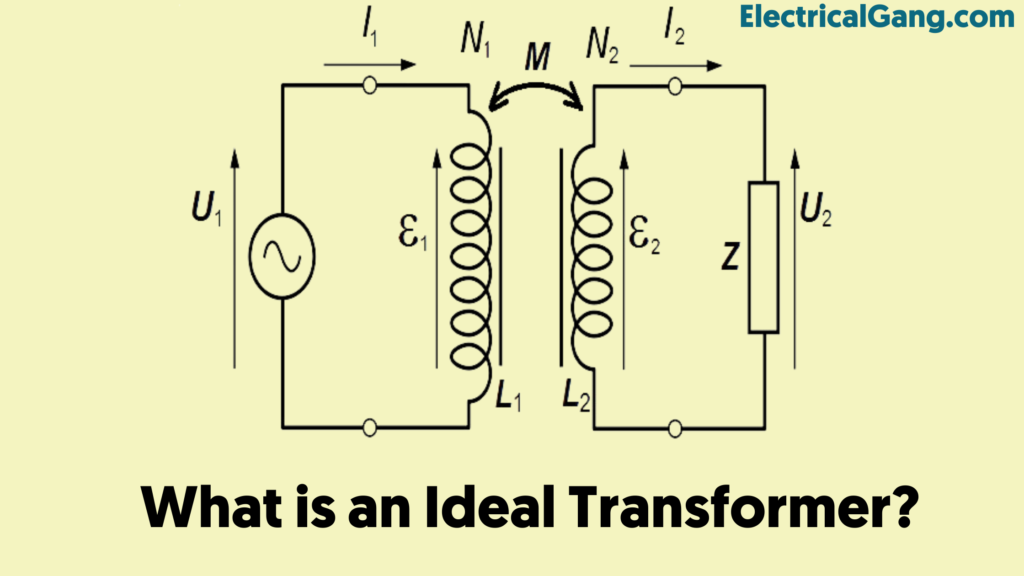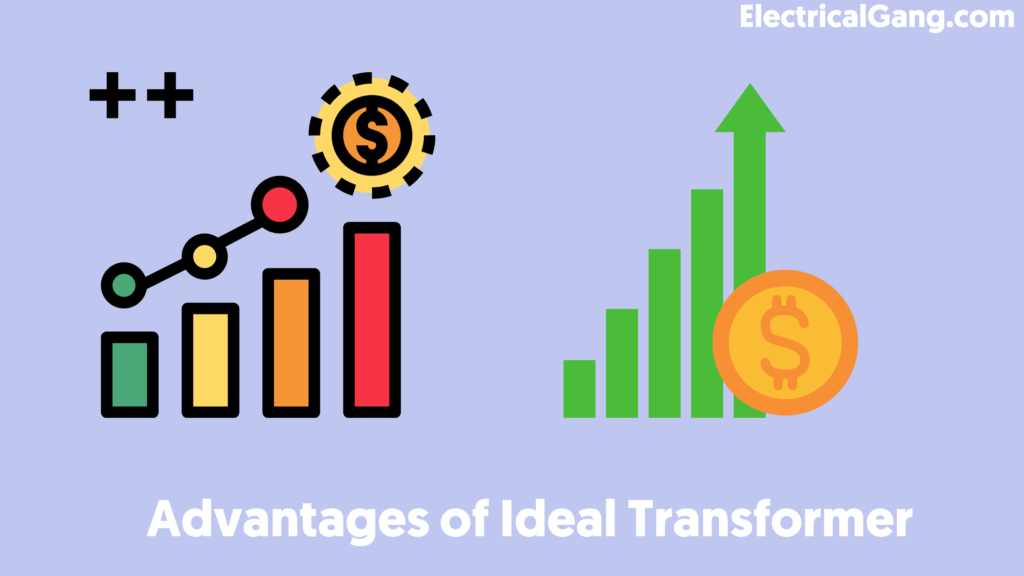
Before we talk about an ideal transformer, we will talk about a simple transformer. A transformer is a fixed electrical device that does not involve a rotating part of any kind like a motor. A transformer is used to maintain a constant frequency and to transfer electrical energy between two circuits during an increase/decrease of current or voltage.
The working principle of the transformer is “Faraday’s law of induction“. When the current in the main winding changes it will change the magnetic current so that the induced EMF can take place in the secondary coil.
An experimental transformer has some losses like core losses, copper losses, etc. Copper loss can also be defined as transformer winding. In which resistance, as well as reaction, causes some damage it is known as copper loss. Core loss in a transformer occurs when the transformer is active. Core losses do not change with the main load. This type of loss is caused by two factors eddy and hysteresis. Due to this loss, the output power of the transformer is less than the input power.
In today’s article, we will see what is the ideal transformer. Today we will see what is the working principle of this and what is its use.
What is an Ideal Transformer?

A transformer that does not incur any loss of any kind such as copper loss, core loss, etc. is known as an ideal transformer. The output power in an ideal transformer is equal to the input power. The efficiency of such a transformer is 100%. This means that there is no loss of electricity of any kind.
Suggested Read: Types of Losses in a Transformer | Efficiency of Transformer
Working Principle of Ideal Transformer:
An ideal transformer works on two principles when the electrical current generates a magnetic field and the changing magnetic field in the coil brings voltage to the end of the coil. When the current in the primary coil changes. Then a magnetic flux develops. So changing the magnetic field can bring voltage across the secondary coil.
When current flows in the primary winding it creates a magnetic field. The two windings are wrapped in a very high magnetic core like iron, so they supply magnetic flux through the windings. Once the load is connected to the secondary coil the voltage and current will be in the directed direction.
Properties of Ideal Transformer:
Some of the properties of Ideal Transformer are as follows:
- The two windings of this transformer include small resistance.
- There is no damage to the transformer due to resistance, eddy current, and hysteresis.
- The efficiency of the Ideal Transformer is 100%.
- The total flux generated in the transformer binds to the core and connects to the winding. That is why its flow and inductance leakage is zero.
- The core has unlimited permeability so a negligible magnetomotive force is required to regulate flux inside the core.
This type of transformer is ideal for three types of transformers. When it does not have leakage flux. There is no resistance in the winding and no loss of iron in the core. The properties of practical as well as ideal transformers are not identical to each other.
Suggested Read: What is a Single Phase Transformer | Construction of Single Phase Transformer | Application of Single Phase Transformer
Ideal Transformer Equations:
The properties we discussed above do not apply to a practical transformer. The output power in Ideal Transformer is the same as the input power. Thus, there is no loss of power.
E2*I2*CosΦ = E1*I1*CosΦ otherwise E2*I2 = E1*I1 E2/E1 = I2/I1
Similarly, the conversion ratio equation is shown below.
V2/V1= E2/E1 = N2/N1 = I1/I2 =K
The flows of primary and secondary are inversely proportional to their respective twists.
Phasor Diagram of Ideal Transformer:
The phasor diagram of the Ideal Transformer is as follows. Since the primary transformer coil is fully inductive, the input voltage V1 induces a magnetizing current in the transformer leg 90º.

E 1 and E 2 are induced emf in the primary and secondary windings of the transformer. The direction of the induced emf is inversely proportional to the applied voltage.
Advantages of Ideal Transformer:

The Benefits of an Ideal Transformer are as follows:
- No losses like hysteresis, eddy, and copper losses occur in this transformer.
- The voltage and current ratio depend entirely on the twist of the coil.
- It is not based on frequency.
- Absolute linearity.
- There is no flux leakage.
- No stray inductance and capacitance.
Most Commonly Asked Questions:

What is the ideal transformer equation?
This value is determined by the power factor but for an Ideal transformer, it remains the same. That is why V1I1 = V2I2 is expressed by this ratio. V 1 V 2 = I 2 I 1. This shows that if the transformer carries the voltage to a higher value, the current will decrease accordingly.
What are the characteristics of an ideal transformer?
This type of transformer has no winding resistance and no reaction. Which eliminates the loss of copper inside the transformer. There is no major damage i.e. no hysteresis loss or eddy current loss. There is no leakage flow. The entire magnetic flux is connected by a core.
What are the 3 types of transformers?
There are three primary types of voltage transformers (VT): electromagnetic, capacitor, and optical.
What is the transformer ratio?
The transformer turn ratio is divided by the number of turns of the primary winding and the number of turns of the secondary coil. The transformer turn ratio provides the expected operation of the transformer and the required voltage at the secondary winding.
Like this post? Could you share it with your friends?
Suggested Read –